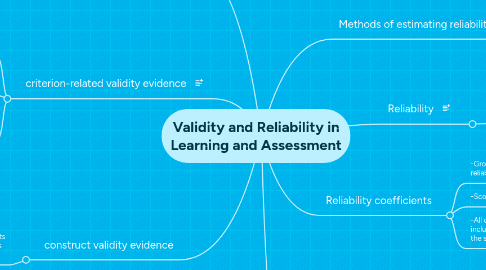Validity and Reliability in Learning and Assessment
von Deb Parks


1. content validity evidence
1.1. -is assessed by systematically comparing a test item with instructional objectives to see if they match
1.2. -does not yield a numerical estimate of validity
2. criterion-related validity evidence
2.1. concurrent validity evidence
2.1.1. -is determined by correlating test scores with a criterion measure collected at the same time.
2.2. predictive validity evidence
2.2.1. -is determined by correlating test scores with a criterion measure collected after a period of time has passed.
2.3. -established by correlating test scores with an external standard or criterion to obtain a numerical estimate of validity evidence
3. construct validity evidence
3.1. -is determined by finding whether test results correspond with scores on other variables as predicted by some rationale or theory
4. Reliability coefficients
4.1. -Group variability affects the size of the reliability coefficient.
4.2. -Scoring reliability limits test score reliability.
4.3. -All other factors being equal, the more items included in a test, the higher the reliability of the scores.
5. Methods of estimating reliability:
5.1. -test-retest or stability
5.2. -alternative form
5.3. -internal consistency
5.3.1. -split-half methods
5.3.2. -Kuder-Richardson methods
